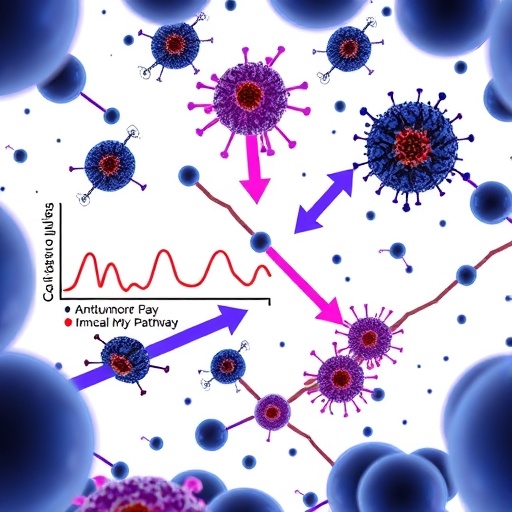NAT10, known primarily for its role in RNA modification through acetylation, has previously been implicated in several cellular processes, ranging from DNA damage repair to regulation of gene expression. However, its function within the tumor microenvironment, particularly how it influences immune evasion, remained largely unexplored until now. The current research highlights how NAT10 acts as an intrinsic suppressor of antitumor immunity, allowing neoplastic cells to shroud themselves from immune detection. By targeting NAT10, the researchers effectively dismantled this shield, provoking an innate immune onslaught capable of controlling tumor progression.
Central to the mechanism revealed is the activation of the type I interferon pathway, a group of cytokines integral to antiviral responses and immune modulation. The study demonstrates that NAT10 inhibition provokes a cascade that elevates levels of type I interferons, such as IFN-α and IFN-β, which in turn stimulate the recruitment and activation of cytotoxic immune cells, including natural killer cells and CD8+ T lymphocytes. This effect essentially converts an immunologically cold tumor microenvironment into a hotbed of immune activity, thus restoring the body’s ability to recognize and attack tumor cells.
.adsslot_EHsYjvQ87D{ width:728px !important; height:90px !important; }
@media (max-width:1199px) { .adsslot_EHsYjvQ87D{ width:468px !important; height:60px !important; } }
@media (max-width:767px) { .adsslot_EHsYjvQ87D{ width:320px !important; height:50px !important; } }
ADVERTISEMENT
Crucially, the researchers delve into the molecular underpinnings that connect NAT10 inhibition to immune activation. They reveal that this process hinges on the suppression of the oncogenic MYC protein, a master regulator of cellular proliferation frequently overexpressed in various cancers. MYC interacts with cell cycle kinase CDK2 and the DNA methyltransferase DNMT1 to maintain epigenetic landscapes conducive to tumor survival. Inhibiting NAT10 disrupts this MYC/CDK2/DNMT1 axis, triggering epigenetic changes that unleash the transcriptional program underlying type I interferon production.
From a translational perspective, these findings carry profound implications. Tumors with high NAT10 expression tend to be refractory to existing immunotherapies, including checkpoint inhibitors, which depend on pre-existing immune activity within the tumor microenvironment. Interfering with NAT10 could reprogram these resistant tumors, rendering them more susceptible to immunotherapeutic interventions. This opens the door to combinatory treatment approaches, where NAT10 inhibitors synergize with current immunotherapies to enhance clinical outcomes.
Further biochemical assays revealed that NAT10 enzymatic activity modulates acetylation marks on RNA molecules, particularly within regions that regulate interferon-stimulated gene expression. The altered acetylation status is believed to enhance chromatin accessibility at key immune loci, thus facilitating a potent antiviral-like immune response within tumors. This intricate epigenetic reprogramming underscores the complexity of NAT10’s role and highlights potential biomarkers for monitoring therapeutic efficacy.
The interplay between tumor cell-intrinsic factors and immune activation reported here expands current paradigms in cancer immunology. Where previously the focus was largely on external immune checkpoint blockade or adoptive cell therapies, this study puts tumor-intrinsic molecular machineries like NAT10 on the radar as critical immune modulators. It also challenges the notion that tumor cells are passive recipients of immune attack; instead, it positions them as active agents capable of constructing immune-suppressive niches.
Moreover, the MYC/CDK2/DNMT1 pathway identified as the relay through which NAT10 exerts its immune suppressive effects is a well-established oncogenic circuit, notorious for driving cellular proliferation and metabolic rewiring. The revelation that this pathway also regulates immune signaling pathways adds a novel dimension to its functional repertoire, implying that disrupting this axis can simultaneously hinder tumor growth and restore immune competence.
Notably, the type I interferon response elicited by NAT10 inhibition resembles antiviral defense, a primal mechanism conserved across evolution. Tumors often hijack such pathways to evade immune surveillance. By reactivating these ancient defense systems through molecular intervention, the study reveals an elegant strategy to tip the scales back in favor of immune eradication of cancer.
While these findings are compelling, the authors acknowledge certain limitations and call for further work to translate NAT10 inhibition into effective cancer therapies. Identifying selective inhibitors with favorable pharmacokinetics and minimal toxicity remains a critical step. Additionally, stratifying patients based on tumor NAT10 expression or MYC pathway activity may optimize clinical responses, avoiding potential off-target effects in non-tumor tissues where NAT10 plays essential roles.
Looking forward, the integration of NAT10 inhibitors with immune checkpoint blockade, targeted therapies, or conventional chemotherapy could pave the way for next-generation personalized cancer treatments. The dual assault on tumor proliferation and immune evasion holds promise for durable remissions and, ultimately, cures. This research marks a pivotal moment in the quest to harness the full potential of the immune system in combating cancer.
The discovery also opens intriguing questions regarding the broader role of RNA acetylation in tumor biology and immune interactions. Given the rapid expansion of epitranscriptomics as a field, future investigations may identify additional RNA-modifying enzymes acting as novel immunomodulatory targets, further enriching the cancer immunotherapy armamentarium.
In summary, the inhibition of tumor-intrinsic NAT10 represents a powerful maneuver to awaken dormant immune responses against cancer. Through meticulous dissection of the underlying MYC/CDK2/DNMT1 axis and the resulting type I interferon cascade, this study offers a sophisticated blueprint for new therapeutic strategies aimed at reinvigorating antitumor immunity. As the oncology community grapples with treatment resistance, this work shines as a beacon of innovation and hope for patients worldwide.
Subject of Research: Tumor-intrinsic NAT10 inhibition and its role in enhancing antitumor immunity via type I interferon response
Article Title: Inhibition of tumor-intrinsic NAT10 enhances antitumor immunity by triggering type I interferon response via MYC/CDK2/DNMT1 pathway.
Article References:
Liu, Wc., Wei, Yh., Chen, Jf. et al. Inhibition of tumor-intrinsic NAT10 enhances antitumor immunity by triggering type I interferon response via MYC/CDK2/DNMT1 pathway. Nat Commun 16, 5154 (2025). https://doi.org/10.1038/s41467-025-60293-4
Image Credits: AI Generated
Tags: Acetyltransferase enzyme roleAntitumor immunity enhancementBlocking NAT10Cancer immunotherapy strategiescytokines in cancer treatmentImmune Evasion MechanismsImmune system activationMYC signaling pathwayRNA modification in cancerTumor intrinsic NAT10 inhibitiontumor microenvironment modulationType I interferon response





